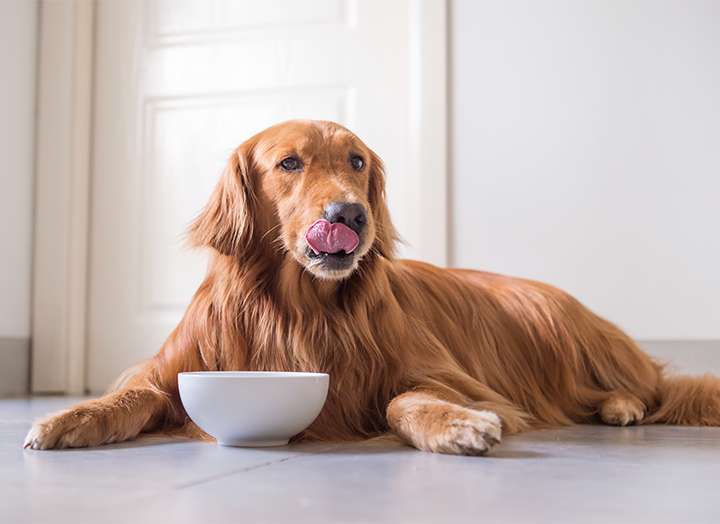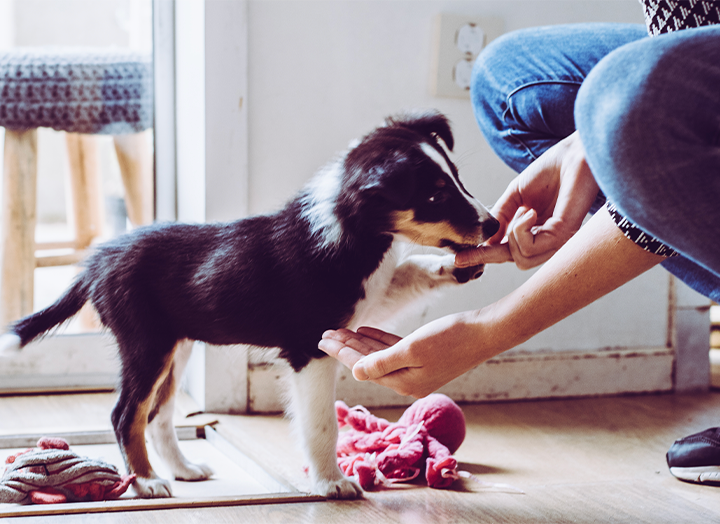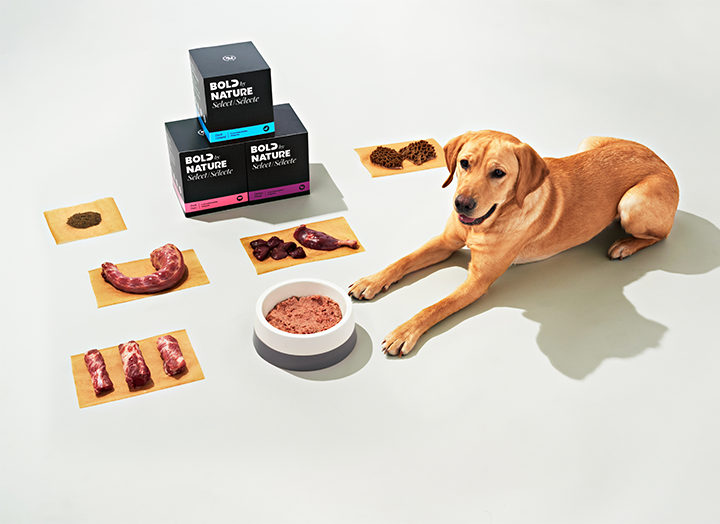[vc_row][vc_column][vc_column_text css=””]
Establishing a consistent feeding routine is not only about convenience but plays a vital role in maintaining your dog’s overall health and well-being. In this dog feeding guide, we’ll explore the significance of a dog feeding schedule, how to determine the right portions and provide practical tips to successfully implement and maintain a schedule.
[/vc_column_text][/vc_column][/vc_row][vc_row][vc_column][vc_row_inner content_placement=”middle”][vc_column_inner width=”1/2″][vc_column_text css=””]
Why is a feeding schedule important?
A dog feeding schedule is more than just a set of meal times; it forms the backbone of your pet’s daily routine. Feeding dogs at regular mealtimes promotes a healthy metabolism, which in turn contributes to maintaining a consistent energy level throughout the day. Moreover, scheduled feedings help dogs properly digest food and reduce the risk of bloating or gastrointestinal discomfort. Additionally, a predictable routine fosters discipline and stability in your dog’s life, offering a sense of security and comfort.[/vc_column_text][/vc_column_inner][/vc_row_inner][vc_row_inner content_placement=”middle”][vc_column_inner width=”1/2″][vc_column_text css=””]
Factors to consider while crafting a feeding schedule
Feeding dogs with a well-crafted schedule requires careful consideration of various factors that influence your dog’s nutritional needs. Some essential factors to consider include:
Feeding dogs based on their age and life stage
Puppies, adult dogs, and senior dogs have unique nutritional requirements. Young puppies need more frequent feedings to support their rapid growth, whereas adult and senior dogs might require adjustments in their diet to match their changing metabolic needs.
Breed and size
Different dog breeds and sizes have varying metabolic rates and energy levels. Larger breeds might need more frequent feeding due to their higher caloric requirements, while smaller breeds may do well with smaller, more frequent meals.
Activity level
How often to feed dogs can also depend on the activity level of your dog. Active and athletic dogs burn more calories during play and exercise and may require additional food to support their energy demands.
Health conditions
If your dog has any health conditions, such as allergies, joint issues, or diabetes, it’s essential to tailor their diet accordingly. Some health conditions may necessitate dietary restrictions or specific types of food to manage their condition effectively.
Individual preferences
Just like humans, you’ll have to take preferences into consideration when feeding a dog. Observe your dog’s eating habits and preferences, and take them into account while crafting their feeding schedule.[/vc_column_text][/vc_column_inner][vc_column_inner width=”1/2″][vc_column_text css=””]

How often should I feed my dog?
While there is no one-size-fits-all answer to how often you should feed your dog, a general guideline based on their age is as follows:
Puppies
Puppies have high energy demands and need more frequent meals. Feed them three to four times a day until they reach around six months of age, then gradually transition to two meals a day. If you have a large breed puppy, more frequent meals are always best, as their food intake is more.
Adult dogs
When feeding a dog that is an adult, consider two meals a day, typically one in the morning and one in the evening. However, some dogs may prefer one larger meal or multiple smaller meals throughout the day.
Senior dogs
As dogs age, their metabolism slows down, and they may benefit from more frequent, smaller meals to aid digestion. When feeding a dog that is older, please take this into consideration.[/vc_column_text][/vc_column_inner][/vc_row_inner][vc_row_inner content_placement=”middle”][vc_column_inner width=”1/2″][vc_column_text css=””]
Portion control
Determining how much to feed a dog is crucial to prevent overfeeding or undernourishment. Refer to the feeding guidelines on your dog’s food package and adjust according to their age, weight, activity level, and overall health. It’s essential to strike the right balance to maintain a healthy weight for your dog. Regularly monitor your dog’s weight and body condition and make necessary adjustments to portion sizes as needed.
The importance of routine
Consistency is the cornerstone of a successful feeding schedule. The AKC says dogs thrive on routines, and a consistent feeding routine contributes to their overall well-being. Routines play a pivotal role in enhancing various facets of your relationship with your dog and encompass essential aspects such as house training, grooming, preempting behavioural issues, and fostering a sense of confidence in your canine companion.
If you’re trying to figure out what time to feed a dog, try to feed them at the same times each day, and maintain a similar schedule for other activities such as exercise and bathroom breaks. Consistency creates a sense of predictability, which can help reduce anxiety and stress in your pup.[/vc_column_text][/vc_column_inner][vc_column_inner width=”1/2″][vc_column_text css=””]

The role of treats
Treats play an essential role in training and rewarding your dog for positive behaviour. However, it’s crucial to exercise moderation with treats to avoid disrupting the balance of your dog’s daily caloric intake. Choose healthy, low-calorie treats and factor them into your dog’s overall daily calorie count. If you find that your dog receives a substantial number of treats daily, consider reducing the portion sizes of their main meals to maintain a healthy balance.
Remember to hydrate!
While focusing on meals, it’s essential not to overlook the significance of hydration. Always provide fresh, clean water for your dog throughout the day. Hydration is as essential as a well-balanced diet for maintaining optimal health.[/vc_column_text][/vc_column_inner][/vc_row_inner][vc_row_inner content_placement=”middle”][vc_column_inner width=”1/2″][vc_column_text css=””]
Are raw diets good for dogs?
Yes! We highly recommend feeding natural pet food like a Bold by Nature raw diet. These diets are low-glycemic, single-protein, and consist of the most basic and essential ingredients that your dog needs.
Raw diets are made up of natural, unprocessed, highly digestible ingredients and nutrients, meaning more is absorbed and less comes out.
These types of diets are also excellent to feed if you’ve started to notice signs of food allergy in dogs.
You can also top off your dog’s meal with Bold by Nature+, our line of pet supplements! Each supplement provides your pet with a boost in their bowl, contributing to various facets of their well-being. For example, Pumpkin with Inulin Prebiotic is a natural supplement that promotes a healthier digestive system. Along with the pumpkin’s amazing natural benefits, this supplement also contains an added source of fibre, which helps to soothe digestive tracts and any sort of digestive upset your pet may be experiencing. Keep in mind that if you’re wondering how much pumpkin to give a dog, it will depend on its weight and size[/vc_column_text][/vc_column_inner][vc_column_inner width=”1/2″][vc_column_text css=””]

Do portions change if I’m feeding raw food?
If you’re wondering how much raw food to feed a dog, their body weight will determine how much they can eat. Here’s an easy-to-understand guide to follow:
Average adult dogs
We recommend 2.5% of their ideal body weight.
Active adult dogs
We recommend 3% of their ideal body weight.
Underweight dogs
We recommend 3% of their ideal body weight.
Overweight dogs
We recommend 2% of their ideal body weight.
Senior dogs
We recommend 2% of their ideal weight.
*Keep in mind that feeding guidelines are not an exact science. We always recommend paying close attention to your dogs body condition. If they start to lose or gain weight, adjust the amount accordingly*
Where can I get Bold by Nature products?
Ready to start your raw food schedule? You can purchase Bold by Nature products like affordable dog food or beef knuckle bones for dogs either online or at a local retailer that carries Bold by Nature. You can even use our handy location finder to explore retailers nearby![/vc_column_text][/vc_column_inner][/vc_row_inner][/vc_column][/vc_row][vc_row][vc_column][vc_column_text css=””]
Conclusion
Establishing a dog feeding schedule requires thoughtful consideration of your dog’s age, breed, size, activity level, and health conditions. A consistent feeding routine not only promotes your dog’s physical health but also contributes to their emotional well-being by providing stability and structure in their lives. As a responsible dog owner, be attentive to your dog’s individual needs and adjust the feeding schedule as necessary. Remember that every dog is unique, and it may take some time to find the perfect feeding routine that suits your furry friend best. With a well-balanced and consistent feeding schedule, you can ensure that your beloved companion leads a happy, healthy, and fulfilling life by your side.
[/vc_column_text][/vc_column][/vc_row]












